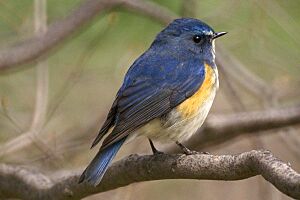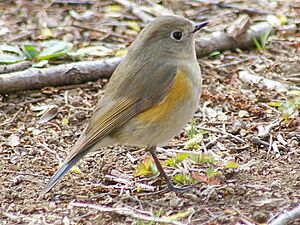Red-flanked bluetail facts for kids
Quick facts for kids Red-flanked bluetail |
|
|---|---|
 |
|
| Male | |
 |
|
| Female | |
| Conservation status | |
| Scientific classification | |
| Genus: |
Tarsiger
|
| Species: |
cyanurus
|
 |
|
| Range of T. cyanurus Breeding Resident Non-breeding | |
| Synonyms | |
|
Luscinia cyanura |
|
The red-flanked bluetail (Tarsiger cyanurus) is a small, colorful bird. It is also known as the orange-flanked bush-robin. This bird used to be thought of as a thrush. Now, scientists mostly agree it is a type of Old World flycatcher. These birds are often called chats.
Where They Live
The red-flanked bluetail is a migratory bird. This means it flies long distances between its summer and winter homes. It loves to eat insects.
These birds spend their summers in forests with conifer trees and thick bushes. You can find them in northern Asia and northeastern Europe. Their summer homes stretch from Finland all the way across Siberia to Kamchatka and south to Japan.
When winter comes, they fly south to warmer places. They spend the colder months mainly in southeastern Asia. This includes the Indian Subcontinent, the Himalayas, Taiwan, and northern Indochina.
Sometimes, these birds wander far from their usual paths. They are rarely seen in Western Europe, especially in Great Britain. A few have even been spotted in North America, mostly in western Alaska.
What They Look Like
The red-flanked bluetail is about 13 to 14 centimeters (5 to 5.5 inches) long. It weighs between 10 and 18 grams. This makes it similar in size to a common redstart. It is a bit smaller than a European robin.
As its name suggests, both male and female birds have a bright blue tail and rump. The rump is the area just above the tail. They also have orange-red patches on their sides, called flanks. Their throat is white, and their belly is grayish-white. They have a small, thin black beak and slender black legs.
Adult male bluetails have dark blue feathers on their upper body. Females and younger males are mostly brown on top. But they still have the blue rump and tail. Their chests are a bit dusky.
These birds act a lot like common redstarts. They often flick their tails. They also fly from a branch to catch insects in the air or on the ground. The male bird sings a sad, trilling song from the tops of trees. Their call sounds like a typical "tacc" noise.
Red-flanked bluetails build their nests on or near the ground. The female bird lays 3 to 5 eggs. She then sits on them to keep them warm until they hatch.
Naming the Bluetail
The scientific name for the red-flanked bluetail is Tarsiger cyanurus. The name Tarsiger comes from ancient Greek and Latin words. Tarsos means "flat of the foot," and gerere means "to carry."
The second part of the name, cyanurus, also comes from Greek. Kuanos means "dark-blue," and oura means "tail." So, the name cyanurus basically means "dark-blue tail."
Scientists sometimes change how they group and name birds. In the past, the red-flanked bluetail was thought to have two main types, called subspecies. One lived in northern Asia, and the other in the Himalaya. Now, many scientists think the Himalayan type is actually a completely different species called the Himalayan bluetail.
There was also another type found in north-central China. This one is now being considered a full species, called the Qilian bluetail. Scientists look at things like their genetics, their songs, and how they look to decide if birds are different species.


